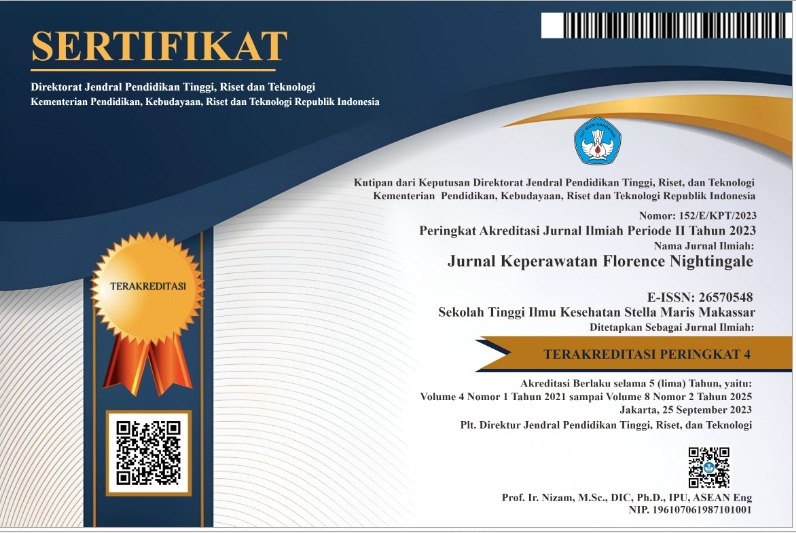The Association of Sedentary lifestyle with Diabetes Mellitus Risk Level in Adolescents
Keywords:
Adolescents, Diabetes Mellitus, Level of Risk, Sedentary BehaviorAbstract
Diabetes mellitus (DM) is a metabolic disease that is generally suffered by adults, but also suffered by many adolescents. Factors causing the high risk of adolescents suffering from DM are a lack of preventive measures and high sedentary behavior, causing a buildup of sugar in the body due to low muscle work. The purpose of this study was to determine the relationship between a sedentary lifestyle and the risk level of DM in adolescents. This study is a correlational quantitative study with a cross-sectional approach. The sample size of this study was 127 respondents from 674 total population selected using a proportionate stratified random sampling technique. The analysis method used was Spearman's rho correlation test. This study uses two research instruments, which are ASAQ and FINDRISC instruments. The results of the study obtained the highest data in high sedentary behavior (74%) and respondents at low risk of DM (72%) with the results of the correlation test p-value=0.031 (<0.05) and r=0.191. This shows that there is a relationship between a sedentary lifestyle and the level of risk of DM in adolescents, with a positive direction. Therefore, adolescents are advised to avoid sedentary behavior to reduce the risk of suffering from DM.
Downloads
References
Ambarita, D. D. L., Prabawati, D., & Hidayah, A. J. (2022). Hubungan Gaya Hidup Sedentary Terhadap Kejadian Tinggi Prediabetes di Wilayah Kerja Puskesmas Johar Baru. Jurnal Ilmiah Keperawatan Stikes Hang Tuah Surabaya, 17(1). Retrieved from http://journal.stikeshangtuah-sby.ac.id/index.php/JIK
Aprilia, R., Sriati, A., & Hendrawati, S. (2020). Tingkat Kecanduan Media Sosial pada Remaja. Journal of Nursing Care, 3(1), 41–53. https://doi.org/10.24198/jnc.v3i1.26928
Arihandayani, Y., & Martha, E. (2020). Perilaku Sedentari Siswa SMP di Kecamatan Cibinong Kabupaten Bogor Jawa Batar Tahun 2018. Jurnal Ekologi Kesehatan, 19(1), 76–83. https://doi.org/10.22435/jek.v19i1.2685
CE Naticias Financieras. (2021). These are the Consequences of Sedentary Lifestyles for Health. ContentEngine LLC. ContentEngine LLC, a Florida Limited Lialibility Company. Retrieved from https://www.proquest.com/wire-feeds/these-are-consequences-sedentary-lifestyles/docview/2515550036/se-2?accountid=25704
Cho, N. H., Shaw, J. E., Karuranga, S., Huang, Y., da Rocha Fernandes, J. D., Ohlrogge, A. W., & Malanda, B. (2018). IDF Diabetes Atlas: Global estimates of diabetes prevalence for 2017 and projections for 2045. Diabetes Research and Clinical Practice, 138, 271–281. https://doi.org/10.1016/j.diabres.2018.02.023
Dinas Kesehatan Sumedang. (2021). Profil Kesehatan Sumedang Tahun 2021.
Dinas Kesehatan Sumedang. (2022). Profil Dinas Kesehatan Kabupaten Sumedang 2022.
Fajanah, F. (2018). Faktor-Faktor Determinan Sedentary Lifestyle pada Remaja (Studi di SMP Negeri 29 Semarang). Semarang. Retrieved from http://repository.unimus.ac.id
Guo, C., Zhou, Q., Zhang, D., Qin, P., Li, Q., Tian, G., … Hu, D. (2020). Association of total sedentary behaviour and television viewing with risk of overweight/obesity, type 2 diabetes and hypertension: A dose–response meta-analysis. Diabetes, Obesity and Metabolism, 22(1), 79–90. https://doi.org/10.1111/dom.13867
Hardianto, D. (2020). Comprehensive Review of Diabetes Mellitus: Classification, Symptoms, Diagnosis, Prevention, and Treatment. Retrieved from http://ejurnal.bppt.go.id/index.php/JBBI
Hardy, L. L., Booth, M. L., & Okely, A. D. (2007). The reliability of the Adolescent Sedentary Activity Questionnaire (ASAQ). Preventive Medicine, 45(1), 71–74. https://doi.org/10.1016/J.YPMED.2007.03.014
Imelda, S. I. (2019). Faktor-Faktor Yang Mempengaruhi Terjadinya diabetes Melitus di Puskesmas Harapan Raya Tahun 2018. Scientia Journal, 8(1), 28–39. https://doi.org/10.35141/scj.v8i1.406
International Diabetes Federation. (2021). IDF Diabetes Atlas, 10th edn. Retrieved from https://www.diabetesatlas.org/
Irwan, I., Ahmad, F., & Bialangi, S. (2021). Hubungan Riwayat Keluarga Dan Perilaku Sedentari Terhadap Kejadian Diabetes Melitus. Jambura Journal of Health Sciences and Research, 3(1), 103–114. https://doi.org/10.35971/jjhsr.v3i1.7075
Jariana, Sudirman, & Afni, N. (2018). Faktor-Faktor yang Berhubungan dengan Terjadinya Diabetes Melitus pada Pasien Rawat Jalan di RSUD Mamuju Utara. 1(1), 186–197. https://doi.org/https://doi.org/10.56338/jks.v1i1.350
Katzmarzyk, P. T., Powell, K. E., Jakicic, J. M., Troiano, R. P., Piercy, K., & Tennant, B. (2019). Sedentary Behavior and Health: Update from the 2018 Physical Activity Guidelines Advisory Committee. American College of Sports Medicine, 51(6), 1227–1241. https://doi.org/10.1093/med/9780192843968.003.0018
Kemenkes Republik Indonesia. (2013). Riset Kesehatan Dasar (RISKESDAS) 2013. Kementerian Kesehatan Republik Indonesia.
Kemenkes Republik Indonesia. (2018). Riset Kesehatan Dasar (RISKESDAS) 2018. Kementerian Kesehatan Republik Indonesia.
Khalish, N., & Hansen. (2021). Literatur Review Hubungan IMT dengan Kadar Gula pada Penderita Diabetes Mellitus Tipe 2. Borneo Student Research, 2(3), 1987–1995. Retrieved from https://journals.umkt.ac.id/index.php/bsr/article/view/2036
Maidartati, Hayati, S., Anggraeni, D. E., Irawan, E., Damayanti, A., & Silviani, D. A. R. (2022). Gambaran Sedentary Lifestyle Pada Remaja Di SMA Kota Bandung. Jurnal Keperawatan BSI, 10(2), 250–265. Retrieved from https://ejurnal.ars.ac.id/index.php/keperawatan/article/view/889
Nafi’ah, N., & Nurlaella, E. H. (2022). Perilaku Sedentari dan Determinannya. Media Publikasi Promosi Kesehatan Indonesia, 5(12), 1498–1505. Retrieved from https://doi.org/10.31934/mppki.v2i3
Nasution, F., Andilala, & Siregar, A. A. (2021). Faktor Risiko Kejadian Diabetes Melitus. Jurnal Ilmu Kesehatan, 9(2), 94–102. https://doi.org/https://doi.org/10.32831/jik.v9i2.304
Nur, A., Wilya, V., & Ramadhan, R. (2016). Kebiasaan Aktivitas Fisik Pasien Diabetes Mellitus Terhadap Kadar Gula Darah di Rumah Sakit Umum dr. Fauziah Bireuen. SEL (Jurnal Penelitian Kesehatan, 3(2), 41–48. Retrieved from http://ejournal.litbang.depkes.go.id/index.php/sel/article/view/6381
Oematan, G., & Oematan, G. (2021). Sleep duration and sedentary activity as a risk factor for obesity hypertension in. Ilmu Gizi Indonesia, 04(02), 147–156. https://doi.org/https://doi.org/10.35842/ilgi.v4i2.208
Park, J. H., Moon, J. H., Kim, H. J., Kong, M. H., & Oh, Y. H. (2020). Sedentary Lifestyle: Overview of Updated Evidence of Potential Health Risks. Korean Journal of Family Medicine, 41(6), 365–373. https://doi.org/10.4082/KJFM.20.0165
Pertiwi, P., Perwitasari, D. A., & Satibi, S. (2021). Validation of Finnish Diabetes Risk Score Indonesia Version in Yogyakarta. Borneo Journal of Pharmacy, 4(1), 57–67. https://doi.org/10.33084/bjop.v4i1.1575
Punthakee, Z., Goldenberg, R., & Katz, P. (2018). Definition, Classification and Diagnosis of Diabetes, Prediabetes and Metabolic Syndrome. Canadian Journal of Diabetes, 42, S10–S15. https://doi.org/10.1016/j.jcjd.2017.10.003
Rofiqoh, S., Widyastuti, W., Aroh, I., & Fijianto, D. (2023). Fruit and Vegetable Eating Habits and Adolescent Physical Activity as an Identification of Diabetes Risk Factors. University Research Colloqium, 1564–1570. Retrieved from https://repository.urecol.org/index.php/proceeding/article/view/2595
Sahayati, S. (2019). faktor risiko kemungkinan timbulnya diabetes melitus pada remaja di kabupaten sleman (skoring DM menggunakan findrisc). Jurnal Formil (Forum Ilmiah) Kesmas Respati, 4(2), 201. https://doi.org/10.35842/formil.v4i2.271
Sambo, M., Amelyani, S., & Simon, S. (2023). Hubungan Sedentary Lifestyle dengan Obesitas Pada Anak Usia Remaja Pada Masa Pandemi. Jurnal Keperawatan Florence Nightingale, 6(2), 43–47. https://doi.org/10.52774/jkfn.v6i2.120
Sipayung, R., Siregar, F. A., & Nurmaini. (2018). Hubungan Aktivitas Fisik dengan Kejadian Diabetes Melitus Tipe 2 pada Perempuan Usia Lanjut di Wilayah Kerja Puskesmas Padang Bulan Medan Tahun 2017. Jurnal Muara Sains, Teknologi, Kedokteran, Dan Ilmu Kesehatan, 2(1), 78–86.
Ulya, N., Zanetha, A., Sibuea, E., Purba, S. S., Ikka, A., & Herbawani, C. K. (2023). Analisis Faktor Risiko Diabetes pada Remaja di Indonesia. Jurnal Kesehatan Tambusai, 4(3), 2332–2341. https://doi.org/https://doi.org/10.31004/jkt.v4i3.16210
Utomo, A. A. U., R, A. A., Rahmah, S., & Amalia, R. (2018). Faktor Risiko Diabetes Melitus Tipe 2: A Systematic Review. Jurnal Kebidanan Dan Keperawatan Aisyiyah, 13(2), 120–127. https://doi.org/10.31101/jkk.395
Wardana, F. (2020). Studi Literatur Pengaruh Pendidikan Kesehatan Terhadap Aktivitas Sedentari pada Remaja (Universitas Muhammadiyah Malang). Universitas Muhammadiyah Malang. Retrieved from https://eprints.umm.ac.id/id/eprint/69467
Published
How to Cite
Issue
Section
Copyright (c) 2024 Ressa Julliyana, Popi Sopiah, Rafika Rosyda

This work is licensed under a Creative Commons Attribution-ShareAlike 4.0 International License.









